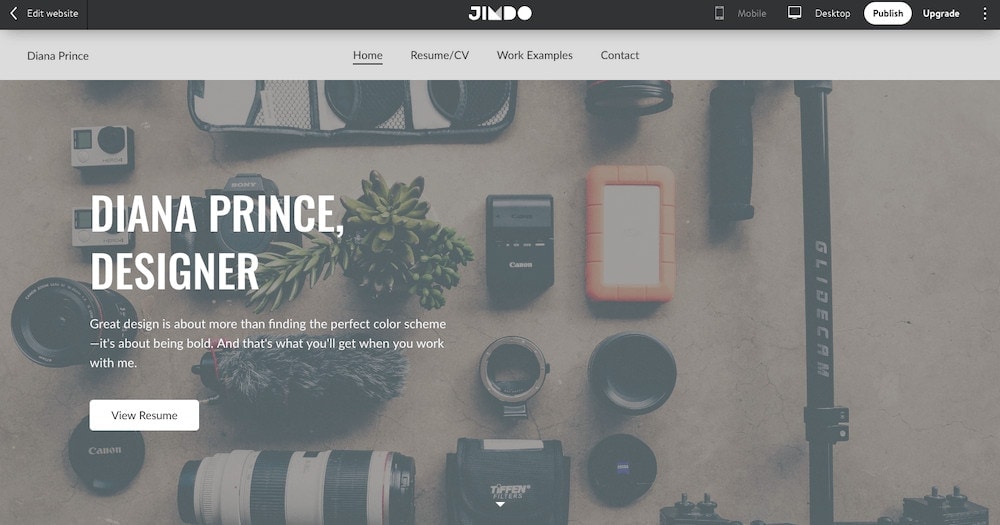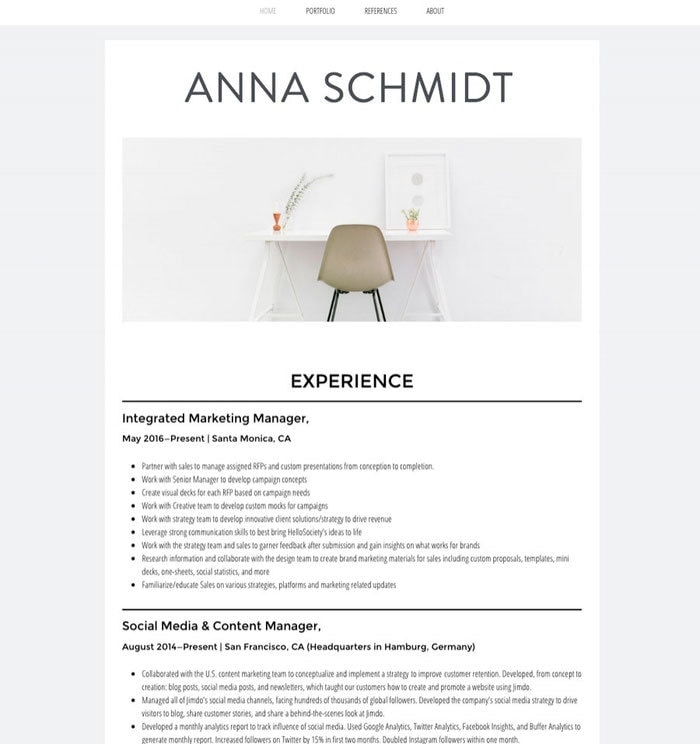It’s hard to write a resume, especially if you have no work experience yet. Bullet points and black and white text don’t always show what you can do, or help you stand out.
Fortunately there’s a better way for job seekers to put their resumes online and find a job, and that’s building your own resume website. In this post we’ll go through some top tips for resume and CV websites, and examples of do’s and don’ts.
Learn how to start your own website today!
What’s the difference between an online CV and resume?
A CV is a comprehensive picture of your entire professional history, while a resume is a brief summary of your top skills and experience. A CV (“curriculum vitae”) will list everything you’ve done in your career and education. A resume will focus on what’s relevant for the specific job you’re applying for in 1-2 pages. Resumes are widely-used in the US and Canada. CVs are more common in Europe, and for government or academic positions.
When it comes to a CV or resume website, you can use either one depending on the kinds of jobs you’re looking for. Even though a PDF resume should still be only 1-2 pages, you can use the rest of the website to add more context and color.

What pages should your resume website have?
You can do a lot more than just copy-and-paste the text from your resume. Here are some tips for what to put on a website for your job search:
- Homepage
- Resume/CV
- References
- Work Examples & Accomplishments
- Contact Form
Learn how to start your own website today!
1. Homepage
Your homepage is your chance to introduce yourself and let hiring managers know they’ve come to the right place. Make sure your name and your title/position are clearly visible in your website’s title and Header Text. Then give a brief introduction of who you are and the kinds of work you do.
Unless you are in a creative field with amazing photography or visuals to show off, it’s probably best to keep your background as a simple, solid color, with a small, flattering headshot of you. Here are some more tips for portfolio websites.
With Jimdo, you just answer a few questions and the smart system builds the website for you, with all the pages you need. Connect your social media accounts, and we’ll pull in your existing information so it’s ready to go, all in one place.
2. Resume/CV
Some people like to put their entire resume on the homepage. The advantage of that approach is that it wastes no time—it gives recruiters exactly what they’re looking for without having to click anywhere else. Another approach is to give your resume its own page on your website.
This page will be most similar to your paper-and-ink resume. Use Text Blocks to break up the page into sections and bulleted lists. On this page it’s best to keep it simple. Even though a resume website gives you the chance to do a lot of creative things, you still want to provide hiring managers with what they are looking for: a straightforward list of what you’ve done.

3. References
In many resumes, you provide a list of references and hope that hiring managers will call them to hear how great you are. With your own website, you can show exactly what your mentors and colleagues think of you. That way employers get a sense of what you’re like to work with, without even needing to pick up the phone.
Ask your mentors, colleagues, or past customers to write a short testimonial about why they like to work with you and include those snippets on this page. You could also copy any references you have from your LinkedIn profile.
4. Work Examples & Accomplishments
A good resume website can show your work rather than just talk about it in the abstract. This is your chance to break out of the boring bullet points that make up most resumes. If you’re in a creative or visual field, this page is where you would include photos, videos, or links to your work.
If you’re in a more traditional field, you can still give examples of the kind of work you’ve done and what you’ve accomplished. Think to yourself “what am I most proud of?” Rather than the “raised revenue by 25% over Q3 earnings…”, try to describe your success in a narrative way, so that employers can get a sense of how you work. Here are more tips on how to write about yourself on your website.
5. Contact Form
Make it easy for people to get in touch with you. You can create a separate Contact page with your information and a contact form. Or add a Contact Block to your homepage.
6. Custom Domain
To show that you’re really serious about your career, definitely invest in your own personal domain or website address. Ideally, you will be able to snag your name as a .com, but if you’re John Smith that’s probably not going to work (sorry, John Smith!) Adding your middle initial can help or adding your job title as in johnsmiththebaker.com or johnsmithconsulting.com. Here are more tips on how to choose your own domain.
See how to put your work online, with no coding
More ideas for building your resume website
Every resume website needs enough text so that search engines can find you. But if you’re feeling like things are getting too text-heavy, here are some more ideas of what you can add:
- Links to any newspaper articles or press coverage about you.
- Links to pieces you’ve written on other websites.
- Videos of you presenting
- Easy infographics that bring any dry numbers to life (Try services like Infogram or Piktochart to create your own).
- Other multimedia like interactive timelines to show your professional accomplishments over time.
Do’s and don’ts of resume websites
- Do still include a PDF file download of your resume on your website. Some people still prefer the paper version (or will need it as they go through the hiring process).
- Don’t break up your resume into too many separate pages. You don’t need a page for education, another for experience, and another for skills. That just means that people have to click multiple times to get the full picture of who you are. Make their lives easier and put all the important info on one or just a few pages. Here are tips on how to build a site plan.
- Do add links to your public social media profiles, if they’re work appropriate. Make your social media accounts private if they are not relevant to your job search or professional life.
- Do add testimonials. One advantage of a resume website is that you can add more context, including testimonials from previous employers or colleagues. If you have no work experience, adding testimonials from friends, teachers, or people you’ve volunteered with can be particularly helpful social proof in the absence of resume bullets.
- Don’t exaggerate or include irrelevant information. There’s a reason resumes are 1-2 pages. Employers only want the essentials. The same goes for your website.
- Do get a nice headshot. If you’re awkwardly cropping out relatives or posting something blurry, it’s time to invest in a better photograph of yourself.
- Do make your resume website feel unique. Even if you’re not a designer, here are some easy ways to customize the design of your website.
- Don’t spend so much time on the design that you forget about content. You might have great fonts and colors, but at the end of the day you need to have the skills to do the job. That’s why it’s important to focus on your bullet points and describe your experience clearly.
A good resume website evolves with your career
When your resume is just a PDF, it’s a static document that will never change or get updated. A website, on the other hand, is easy to change whenever you gain new skills or experiences. And then, once you’re hired for that dream job, your resume website can evolve into a professional portfolio site that stays with you throughout your career, through changing jobs and changing tastes.

